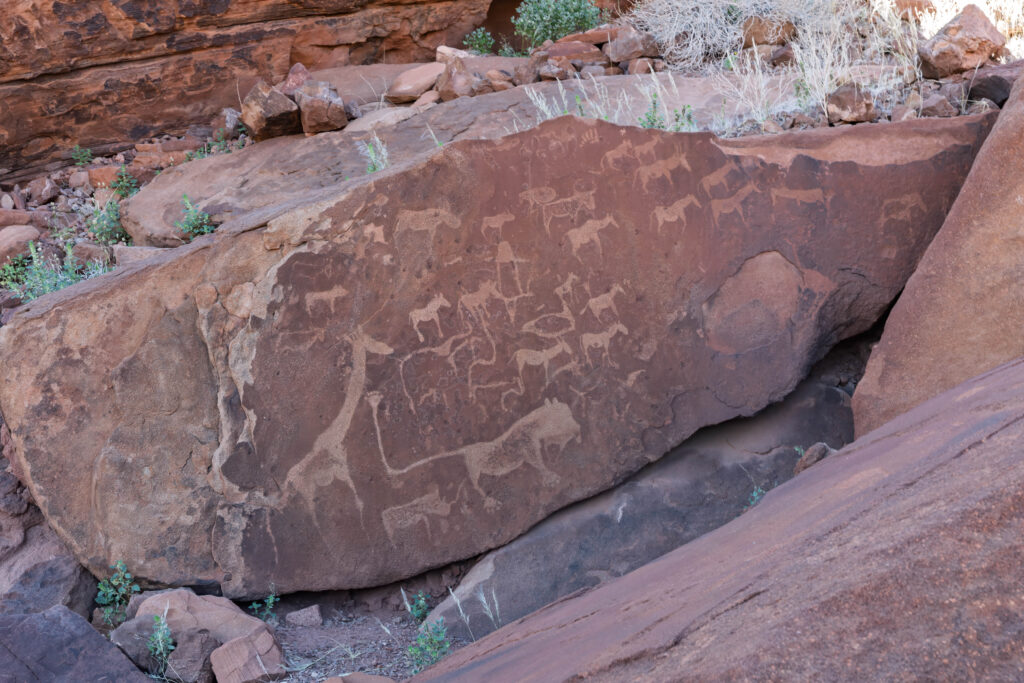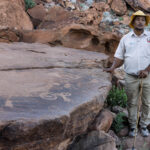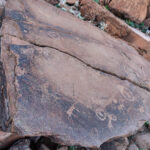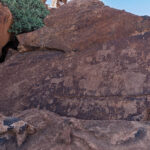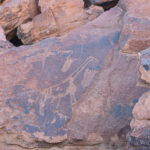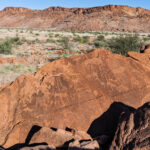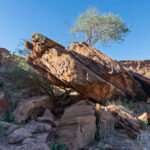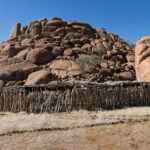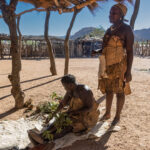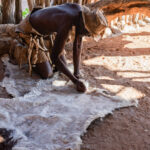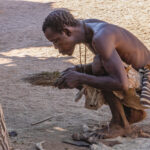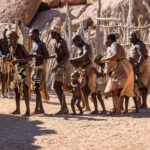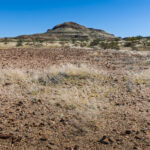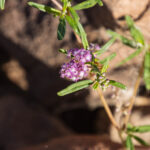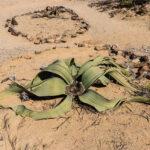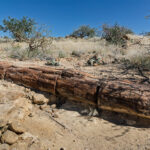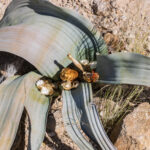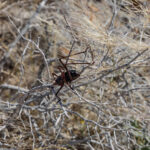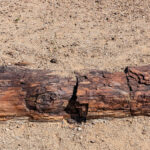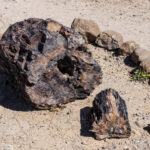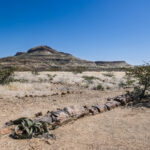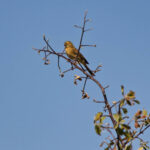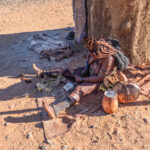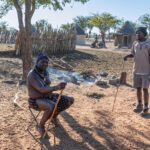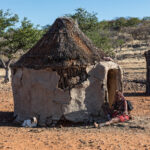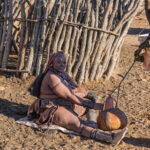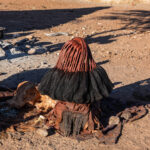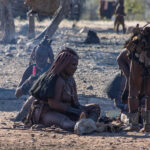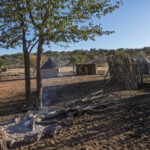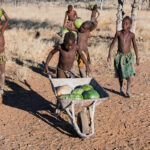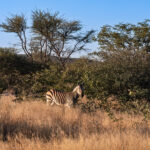Friday, 30 May 2025
Yesterday when we checked in we were promised hot showers for our early morning departure this morning. Wian really wanted us on the road by 6.30am with a big day of activities and many kilometres to cover. Staff will be up at 3.30am to light the fires below your hot water tanks they said. Hmmn, when I stepped into the shower at a quarter past five I was pretty sure I could hear someone outside only just setting the fire going. OK, a cold splash and dash it was then.
After our early awakening without the benefit of a hot shower, it was off down to the lounge to collect our breakfast boxes and meet Wian. He was incredibly frustrated that he wasn’t allowed to drive the bus up to collect us and our luggage, the camp staff insisted that bodies and bags would have to be ferried down in their vehicles. Despite Wian’s repeated entreaties yesterday that the staff would need to help us get on the road early it all went very slowly. Adding to the problem was the camp’s larger nine seater had the back locked so could only take one person in the passenger seat beside the driver at a time. Eventually all of us and our bags were at the bottom of the hill and we were underway at 6.50am … which was still before the sunrise.
We continued over the veldt on the D2612 to Twyfelfontain a UNESCO World Heritage-listed site that features over 2,500 ancient rock engravings. Our guide, Arthur, walked us around the Zieben Platten National Heritage Site telling us the stories behind these intricate carvings, many which are thousands of years old.
Arthur told us that it was a white settler who named the location Twyfelfontain because of the unreliable spring. The family managed to remain for many years though despite the constant threat of running out of water.
We arrived at the first rock engravings and Arthur pointed out the circles were recorded as a map to local water sources. He said that the carvings were generally made to record the availability of water and game. We continued over a rough and rocky path to several more engraved outcrops, all with instantly recognisable renderings of giraffes, zebras, wildebeest and ostriches. Our final stop was at the rock that features a more spiritual engraving of the so-called Lion Man, that is the site’s most famous image.
A short distance away we stopped at the Damara Living Museum. Together with the Kalahari Bushmen, the Damara belong to one of Namibia’s oldest cultures. Their original culture was a mixture of a hunter-gatherer society and herding, however, during colonisation their loose social structures meant they were unable to defend themselves. Now the traditional culture has become somewhat lost but the Damara working at the museum are doing their best to recover, preserve and share their culture.
The Damara speak a language that includes words but also clicking sounds that are impossible to translate. Our guide introduced herself as click-something. She explained that they do not live in the village, but work there during the day on traditional crafts and activities to keep their culture alive. They all have homes in the local town so, live something of a double life.
She took us around the village to have various colleagues share their knowledge of traditional medicine, beer brewing, prepping skins to make clothing, blacksmithing to make weapons and fire making. Our visit to the museum concluded with some traditional music and dancing.
We next made our way to the Petrified Forest, an accumulation of fossilised tree trunks which are approximately 280 million years old. Our guide here was Ingridt. As we entered the site Ingridt told us that is illegal to remove any fossilised wood from the site. Initially all the wood just looked like a jumble of wood-grained rocks and the welwitschias growing in the wild were more interesting. Soon, however, we arrived at a well preserved specimen of a petrified pine-tree trunk and now we could visualize something that had once been a tree millennia ago. Our path continued past the site’s longest tree trunk, a well-preserved, petrified elm tree (I think she said elm?)
After all these activities concentrated in a small area, it was time to make headway towards our accommodation for tonight. We took the C39 through Khorixas and on to Outjo. By the roadside the animal life continued to be of the domesticated variety: cows, goats and donkeys. Donkeys are very common here and often seen hooked up to small carts to transport people and their goods.
At Outjo we stopped for fuel and food. The food offerings were limited so most members of our party opted to eat ice-creams for lunch! I had been sitting on the sunny side of the bus and I was feeling a bit clogged up like I was coming down with something, so I didn’t fancy anything milky. My ‘healthy’ lunch choice was a Jungle Bar, yoghurt dipped muesli bar.
Bernie agree to swap sides of the bus but the moment we left Outjo we turned onto the B38 now heading north towards Okaukuejo. At least heading directly into the sun meant that nobody really had a seat with the sun blazing in on them. The roadside offerings remained much the same in regard to domestic livestock but there were also many termite mounds beside the road and we spotted a few springboks. At least some wildlife was about. Cute as they are, springbok are a bit dime a dozen though!
We pulled off onto the D2695 to travel along the gravel to the Omapapa Himba Village. On our arrival we were all pleased to avail ourselves of their facilities beside reception while Wian tried to track down a guide. For a while it seemed that our visit might be a non-starter as they did not seem to be expecting our group. By the time that nine people had used two loos to relieve themselves our guide had arrived.
Our guide, Paulinu, introduced himself explaining that this is his adopted name – after a soccer player – with his traditional name being the Himba word for ‘favoured by the leopard’. We already knew from our itinerary that the Himba are traditionally a semi-nomadic people from the far north of Namibia. Paulinu told us that his community has moved south to make their home near Etosha National Park.
The Himba are known for their distinctive practice of covering their skin and hair with butterfat and ochre mixed into a paste known as otjize paste to protect themselves from the harsh climate. Our first stop in the village was with a woman who showed us a container of buttermilk she had prepared. Two young boys who attend the kindergarten that our entry fees help to fund sang us their ABCs. Very cute.
Paulinu pointed out a group of girls grooming their hair, explaining that they braid their own hair then cover part of their braid with otjize paste then traditionally they attached animal tails to the bottom of their hairstyle. Since they are no longer allowed to hunt, the black hair on the bottom of their hairstyle is replicated with hair from cheap, synthetic wigs from China. The whole hair do is quite complicated and they re-do their hair every two weeks.
We met the chief and he explained his role in the village. We also learnt about the holy fire that is laid between his hut and the corral where the goats are put away at night. It is used for medicinal, spiritual and cultural purposes and is NEVER let go out. Fire making is not a skill practiced by the Himba because they always use a coal from the holy to start fires for individual purposes.
We were allowed into the Chief’s hut – women on the right and men on the left – where Paulinu spoke with us further about items from their culture like the skin ‘mattress’ being all that separates them from the ground when sleeping and the wooden pillow that they rest their cheek on at night so that both ears can still hear anything that might threaten the community at night. A man’s wife gets to sleep with her head pillowed on her man’s bicep. We were also shown some traditional hunting tools, containers and a smoke washing machine. One of the young women came in to show us how they use the smoker to bathe/perfume themselves and their clothes.
The village was filled with women, children and goats, LOTS of goats. Paulinu explained that the men spend their days out tending the cattle and they only return to the village in the evening. The villagers also grow kalabash melons – not to eat but to make their storage containers. In the main it is the children who tend the melons and, as we left, we saw a couple of youngsters returning to the village with a wheelbarrow full of melons.
As we left the village Cathy and I both felt a little bit sorry that we had left all of our stationery supplies at Penduka Village in Windhoek as we have had a couple of opportunities where we could have shared our stationery supplies around a bit more.
As we drove back towards the C38 to complete today’s journey I yelled – Zebra! Wian turned the truck around to try to let all of us have a look at our first zebra. He explained that is was not a truly wild zebra, that it was an escapee from the private game reserve we were driving beside. He also told us that if/when the owner learnt about the escapee they would come and shoot it. Sad. Inside the game reserve Wian also pointed out some oryx and some eland. We really only caught a distant glimpse of the eland with Wian saying that might be the only eland that we see because they are very shy and elusive animals.
After a very full day we arrived at our accommodation for tonight at Etosha Village which is located just outside Etosha Park’s Andersson Gate. Tonight we have a slightly different style of glamping although, arguably, these are more like cabins than tents and the ensuite bathrooms are more integrated – we won’t have to keep the door closed between the bedroom and the bathroom like last night. Have to say that we are really enjoying the variety of accommodation that we have been lucky enough to stay in.
With barely time to freshen up; in our rooms it was time to head back to the dining room for dinner. This accommodation is run by the same people as Sossusvlei Lodge so the buffet-style meal service was almost the same as we had enjoyed there but with fewer choices. No matter, we still had plenty of food to choose from.
Bernie took our devices to dinner with us so that we could log into the wi-fi in reception after dinner. Ahem, the moment of truth but, of course, what I had typed into my document on Wednesday night was definitely gone. BUT, where has it gone? Pages kept telling me that the changes I was making might not be saved if I shared a copy of my document BUT, apart from that proviso, it certainly seemed to suggest that my changes would be saved on my iPad.
I looked at Locations in Pages and noted that it had an iCloud Drive option (where my document was) and an On My iPad option. I said to the IT Guy that I thought we had agreed in Cape Town that my document was going to be ON my iPad. The IT Guy insisted that on the iCloud Drive was the same thing – that I could work off-line and my changes would be saved but uploaded to the iCloud automatically the next time my iPad was connected. His theory was that with weak internet or internet dropping in and out that that had caused the problem. Just work off-line all the time and it will save to your iPad he said.
I said that I was struggling to understand how working on an iCloud Drive option was any different from working in Word on OneDrive?? Oh, for the days when I wrote my travel diary with a pen in an actual notebook. I NEVER lost one of those! Or even the days when I first used Pages on my iPad in the distant past before the advent of The Cloud. I don’t trust The Cloud at all, it is way too flakey unless you have a perfect connection.
Now feeling like I really was coming down with a lurgy I was definitely not in the mood for IT problems and the IT Guy and I got a little bit shitty with each other and retired to our room/tent/cabin in a huff.
Steps: 7,040 (4.78kms)


